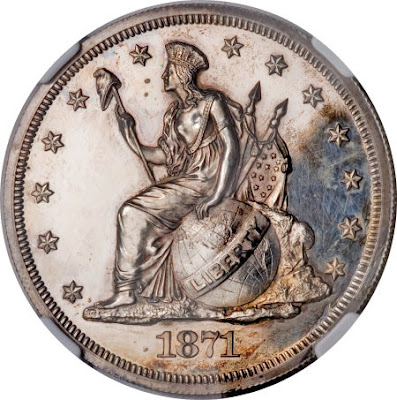 May 14, 2009
May 14, 2009Posted by John Dale
The May Long Beach auction has a pair of unexpected treats in the form of two old-time collections that have been off-the-market for half a century or more. The more prominent of these two collections is the Frank M. Stirling Collection, which contains a number of gorgeous patterns and other coins that come with envelopes from leading dealers of the 1950s. Names such as Hans M.F. Schulman, M.H. Bolender, and B. Max Mehl are all represented. Most interesting is the card accompanying lot 1428,an extremely rare Judd-1138A Indian Princess dollar struck in silver. The card notes that the pattern was previously in the Palace Collections and notes its sale to “F.M. Stirling,” with the signed attestation of Abe Kosoff.
Abe Kosoff was a titan among numismatists of his generation, not only one of the most knowledgeable and prominent dealers of the era but also held in high regard as a gentleman and friend; Q. David Bowers subtitled his biography of Kosoff “Dean of Numismatics,” a title with just the right connotation by virtually all accounts. He died in 1983, before I was born, so I never had the opportunity to meet him, but he left a remarkable body of written work in the form of a series of articles. These articles, published over a 13-year span in Coin World, were collected in the volume Abe Kosoff Remembers… and organized by topic.
One topic, which dominated Kosoff’s column for three months in late 1977 and the start of 1978, is the auction of the Palace Collections of Egypt in 1954. These collections, assembled by King Farouk of Egypt at great cost to the national coffers and confiscated after Farouk was driven out of the country by a military revolt, included coins, stamps, artworks, and antiquities. The coin auction was cataloged by Baldwin of London on-site in Cairo, and the polyglot auctioneer who called the lots was from Sotheby’s. Kosoff reported that his firm, which had sold many coins to King Farouk, made offers to auction the collection and to assist with cataloging, but neither offer met with a favorable reply.
Despite the astonishing accumulation of rarities in the Palace Collections, the prices realized were far less than they could have been. The auction cataloger was not familiar with American coinage, and so fabulous rarities were packaged into large lots alongside more common pieces. The short, vague descriptions scattered throughout the catalog also reflect the writer’s lack of understanding and the enormity of the task that was compressed into mere months.
The auction was a floor-auction only, held in a country far from the United States that was not at all removed from civil unrest; the house arrest and subsequent release of President Naguib took place during the coin auction itself. As a result, many collectors and dealers stayed away, but those bold enough to attend and bid strongly were rewarded many times over. Kosoff himself reported that he bought back many pieces that he had sold to Farouk for a small fraction of their original price, and his firm made money both ways.
Though it is unknown if Farouk purchased the Judd-1138A pattern from Kosoff in the first place, the envelope and card tell their own story of peril, profit, and the stranger-than-fiction relationship between a coin dealer and his royal client.
Click on the title of this post to leave a comment.
-John Dale Beety




No comments:
Post a Comment